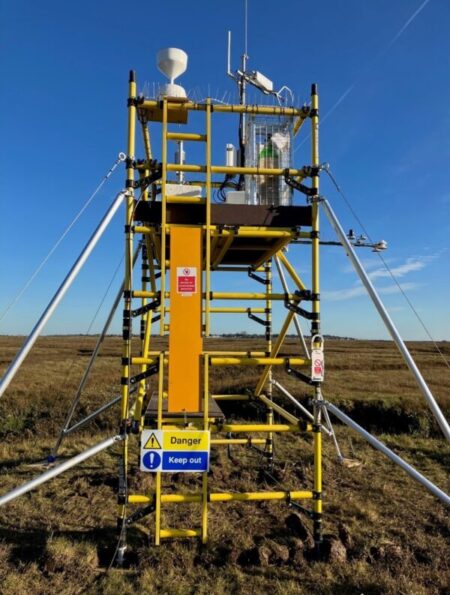It has been announced a new project will see the installation of two flux towers on saltmarshes at RSPB Freiston Shore nature reserve on The Wash near Boston. One tower will be on a natural saltmarsh and the other will be on a restored saltmarsh, this project is in partnership with the RSPB.
Alongside the Linconshire project, a new project has seen the installation of a flux tower on a saltmarsh at Abbotts Hall in the Blackwater Estuary in Essex in partnership with the Essex Wildlife Trust.
Funded through the Defra marine Natural Capital and Ecosystem Assessment (mNCEA) programme, four flux towers on saltmarshes across England have been installed through a partnership between the Environment Agency and the UK Centre for Ecology and Hydrology (UKCEH).
Data Gaps
The towers in Lincolnshire will provide long-term, real-time, data that can help understanding of how saltmarshes function as carbon sinks now and in the future. The Environment Agency and UKCEH scientists, in partnership with the Essex Wildlife Trust, have installed another tower in Essex. A further tower will be added in the future.
Last year, two other towers were installed in the Ribble Estuary by Natural England and WWF. In total, these six towers will provide the first in depth look into greenhouse gas storage and emissions in saltmarshes in England.
Saltmarshes ecosystems provide many valuable services, including habitat for a wide range of species. They also act as natural flood defences and help to capture CO2 from the atmosphere to store it in sediments. It is estimated that 85% of UK saltmarsh has been lost since the mid-19th Century. The towers will help researchers gather data on these ecosystems capture and store carbon, with an aim to increase conservation and restoration of saltmarshes.
Credit: Environment Agency team in East Anglia
Dr Ross Morrison, Biometeorologist at UKCEH said: “Thanks to our new network of coastal flux towers, we’ll provide the first directly measured carbon budgets for a range of different saltmarsh systems across the country by the end of this year, improving our knowledge on how they might help us transition towards our net zero goals.”
Dr Ben Green from the Environment Agency said: “These flux towers will improve our understanding of the ability of saltmarsh habitats to sequester carbon across tides, days, seasons and years. The evidence they will provide will be key to support the further restoration of saltmarshes, and for the inclusion of these habitats on the UK Greenhouse Gas Inventory”.
UKCEH is leading a consortium across charity, finance and academic sectors to develop and pilot a UK Saltmarsh Carbon Code. This rigorous and scientifically-based voluntary certification standard will enable saltmarsh carbon to be confidently purchased, thus providing an income stream for restoration projects and supporting the achievement of national Net Zero goals.
Toby Collett from the RSPB, said: “The Wash estuary and the saltmarshes here are globally important for wildlife, but they are also vital for our way of life, whether that’s fishing, protecting communities from flooding or storing carbon.”
The press releases from the Environment Agency can be read here and here.
